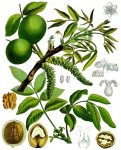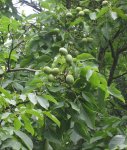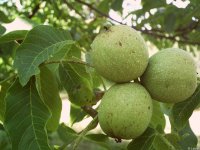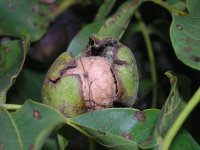Walnut - juglans regia
Family Nut (Juglandaceae).
Botanical characteristics. Monogamous plant, a powerful tree 10 - 35 m high with a sprawling crown and a thick branchy trunk. The bark is clear-gray, wrinkled, in elongated cracks. Leaves are large, regular, odd-pinnate, with 3 to 5 pairs of elongated, pointed, naked from above, from below hairy veins in the corners of the veins of leaves. Flowers are same sex, are collected on 2 - 3. The fruit is an unreal potato. Blossoms in April - May, fruits ripen in September.
Spread. It grows wild in the countries of the Balkan Peninsula, in the Lesser and Middle Asia, and in the Caucasus.
In Russia, it grows and is cultivated as a fruit tree.
Chemical composition. Leaves and pericarp nuts of walnut contain flavonoids, tannins, alkaloids, carotene, vitamin C, yuglon coloring substance, which possesses bactericidal properties, vitamin E. The leaves of walnut on the richness of carotene and vitamin C are in no way inferior to wild rose.
In the fetal nuclei found fatty oil, protein, including free amino acids (asparagine, cystine, glutamine, serine, histidine, valine, phenylalanine). The core is rich in vitamins E, C, K, R, group B, and also contains mineral substances (calcium, iron, cobalt, iodine, etc.). In the shell of seeds - P-sitosterol.
Used parts of the plant. For the preparation of medicines, leaves, green pericarp and green unripe fruit are collected.
Leaves harvested in dry weather and immediately dried, so as not to turn black. Pericarp harvested during harvesting of fruits, dried. Green unripe fruits are harvested during milky wax ripeness, when the inner shell is easily cut with a knife.
Application in medicine. In Europe, walnut is used in official medicine, and we have only in folk medicine, although a number of scientific studies have been carried out to confirm the medicinal properties of the plant and the possibility of its use in phytotherapy.
Drugs made from walnut have a restorative, tonic, krovoochistitelnoe, vasodilating, bactericidal, sugar-reducing, anti-inflammatory, choleretic, diuretic, wound-healing, appetizing, anthelmintic, astringent.
Infusion of leaves and pericarp nuts of walnut has long been used for scurvy, intestinal catarrh, diarrhea , toothache, diabetic periodontal disease, kidney disease, gout, diabetes, atherosclerosis , beriberi.
Fruit shells are used in people in the treatment of hypertension , atherosclerosis, heart diseases.
The broth of the pericarp is used for gastrointestinal diseases, heart diseases, hypertension, liver diseases, hemorrhoids, exhaustion, toxic goiter, anemia, lymph node inflammation, malignancy, uterine bleeding, menstrual irregularities, and whites in women.
Take the infusion of leaves as a hypoglycemic agent. It also has a diuretic effect with cardiac edema, hypertension and atherosclerosis, urolithiasis , and diseases of the bladder.
With gout, articular pains of rheumatic origin, other inflammatory processes in the joints to the sore spots along the nerve trunks apply lotions from the tincture of leaves or make rubbing alcohol infusion of leaves.
Tincture of partitions (lacunae) is useful in toxic and endemic goiter. More often use 20% tincture or a decoction.
A valuable dietary product is the nucleus of nuts .
From unripe fruits in the phase of the formation of a gelatinous kernel, jam is cooked. The core of the walnut nut is included in the diet of patients with diabetes mellitus, atherosclerosis, with increased acidity of the gastric juice. Preparations from mature nuclei are effective in poisoning with salts of heavy metals, in nutrition with radionuclide contamination of food and water as a means of stimulating white blood formation with radiation damage.
Preparation
- Decoction of pericarp nuts walnut: 1 tbsp. L. Dry or finely chopped fresh raw material is poured into 1 glass of water and boiled for 2 minutes. Insist 30 minutes, filter. Take a quarter cup 3 times daily before meals with hypertension, atherosclerosis, exhaustion, goiter, anemia, tumor processes, bleeding, menstrual irregularities.
- Infusion of pericarp nuts walnut: 1 tbsp. L. Raw pour 1 cup of boiling water and insist 1 hour. Filter and take a third cup 3 times daily before meals with beriberi, diarrhea, periodontal disease, gout, diabetes.
- Infusion of walnut leaves: 1 tbsp. L. Raw materials pour 1 cup of boiling water and insist 1 hour. Filter and give on a third cup 3 times daily before meals with diabetes, hypertension, urolithiasis, goiter.
- Decoction of walnut leaves (external): 2 tbsp. L. Raw materials pour 300 ml of boiling water and insist in a warm place for 1 hour, filter and 3 times a day rinse the mouth or throat or use for vaginal douches, trays for hemorrhoids, lotions for external inflammatory processes.
- Tincture of young walnut fruit: Young green nuts in milky ripeness stage are poured with alcohol (70 °) (30 fruits per 1 liter of alcohol) and insist 15 days in a dark place at room temperature. Filter and take 1 tsp. 3 times a day on milk with goiter, diarrhea, peptic ulcer.
- Decoction of the shell of fruit, walnut partitions: 1 tbsp. L. Crushed raw material pour 1 glass of water and boil for 5 minutes. Insist 30 minutes. Filter and take a quarter cup three times a day after meals with hypertension, gout, diabetes, goiter.
- Tincture of walnut kernels: Crush 30 cores and fill them with 1 liter of alcohol (40 °). Insist 2 weeks in the sun. Filter and take 1 tbsp. L. 3 times a day before meals as a firming and hypoglycemic agent.
Homeopathy. Homeopathy uses Juglans 3x, 3 with gastrointestinal diseases, accompanied by nausea and dull pain in the right hypochondrium, diarrhea with a burning sensation in the rectum and a yellowish-green stool; With skin diseases with itching, burning and pustular eruptions.






Comments
When commenting on, remember that the content and tone of your message can hurt the feelings of real people, show respect and tolerance to your interlocutors even if you do not share their opinion, your behavior in the conditions of freedom of expression and anonymity provided by the Internet, changes Not only virtual, but also the real world. All comments are hidden from the index, spam is controlled.